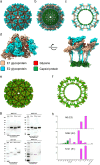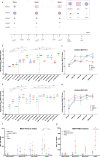Immunogenic recombinant Mayaro virus-like particles present natively assembled glycoprotein
- PMID: 39690153
- PMCID: PMC11652679
- DOI: 10.1038/s41541-024-01021-9
Immunogenic recombinant Mayaro virus-like particles present natively assembled glycoprotein
Erratum in
-
Author Correction: Immunogenic recombinant Mayaro virus-like particles present natively assembled glycoprotein.NPJ Vaccines. 2025 Apr 19;10(1):77. doi: 10.1038/s41541-025-01122-z. NPJ Vaccines. 2025. PMID: 40253359 Free PMC article. No abstract available.
Abstract
Virus-like particles (VLPs) are an established vaccine platform and can be strong immunogens capable of eliciting both humoral and cellular immune responses against a range of pathogens. Here, we show by cryo-electron microscopy that VLPs of Mayaro virus, which contain envelope glycoproteins E1-E2 and capsid, exhibit an architecture that closely resembles native virus. In contrast to monomeric and soluble envelope 2 (E2) glycoprotein, both VLPs as well as the adenovirus and modified vaccinia virus Ankara (MVA) vaccine platforms expressing the equivalent envelope glycoproteins E1-E2, and capsid induced highly neutralising antibodies after immunisation. The levels of neutralising antibodies elicited by the viral-vectored vaccines of structural proteins and VLPs increased significantly upon boosting. Immunisation of Mayaro virus VLPs in mice with or without an adjuvant (poly:IC) yielded similar levels of neutralising antibodies suggesting that the VLPs may be used for immunisation without the need for an adjuvant. A single or two doses of non-adjuvanted 5 µg of MAYV VLP vaccination provided significant protection against viremia and MAYV-induced foot swelling in the C57BL/6 mouse challenge model. MAYV VLPs represent a non-infectious vaccine candidate, which may constitute a complementary option for future immunisation strategies against this important emerging alphavirus.
© 2024. The Author(s).
Conflict of interest statement
Competing interests: The authors declare no competing interests.
Figures





References
Grants and funding
LinkOut - more resources
Full Text Sources

